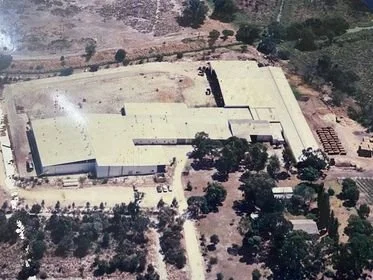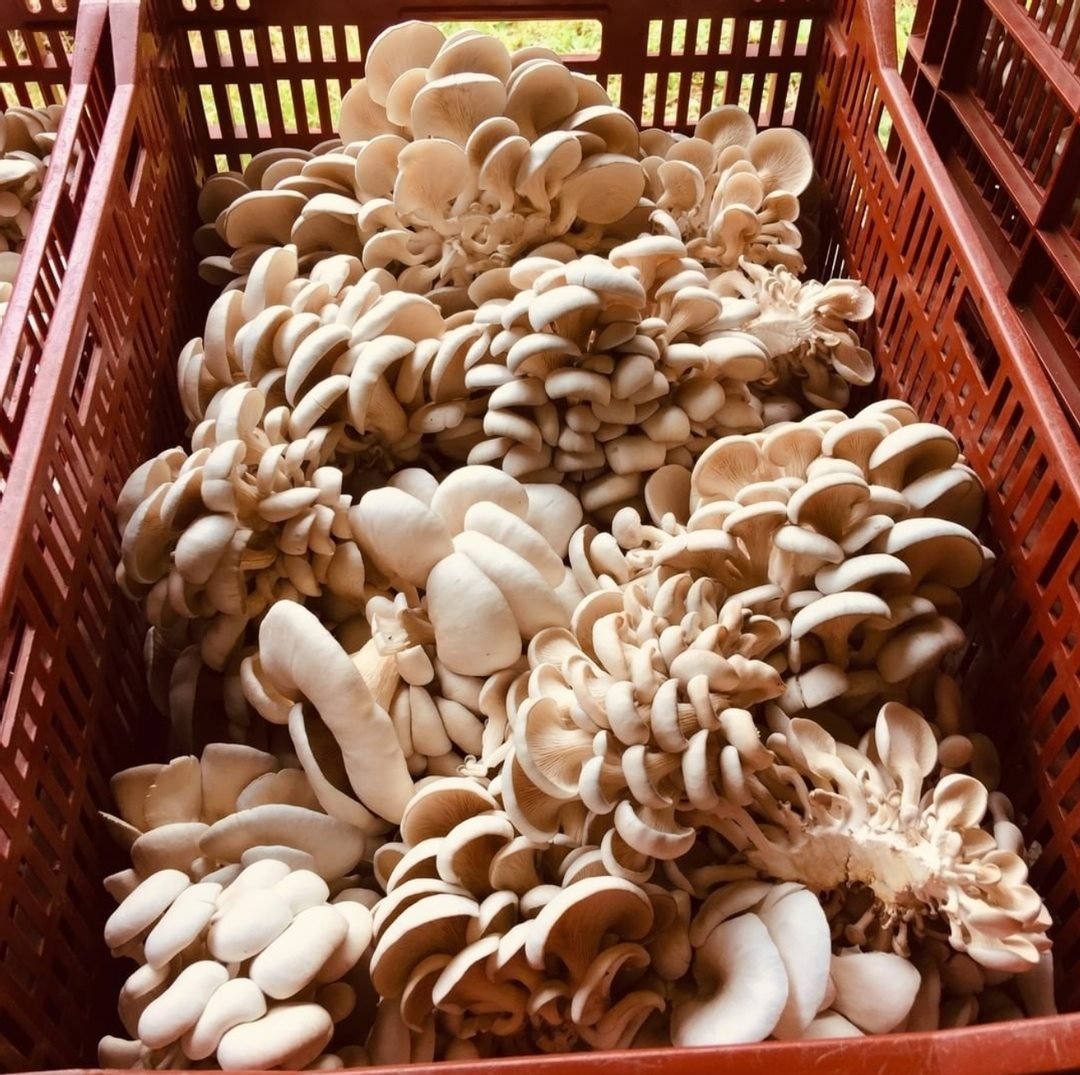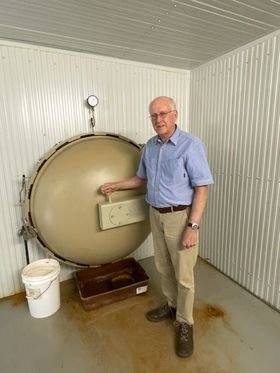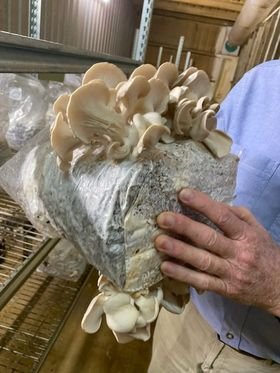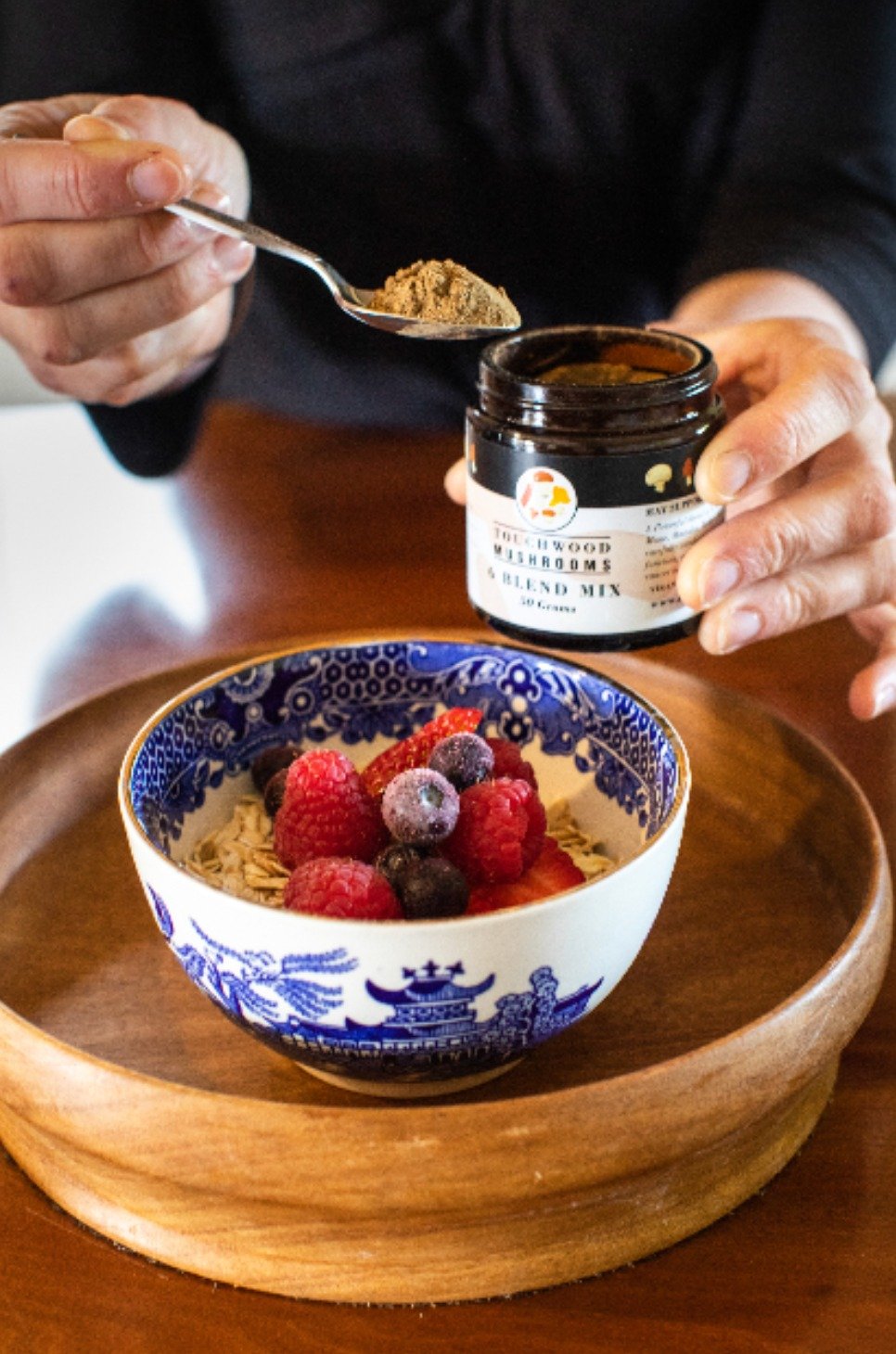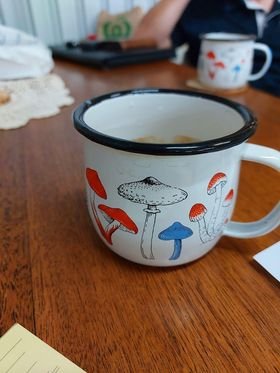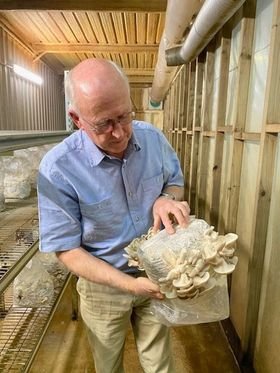Graham and Lee Upson
Rob and Michelle visited Graham and Lee Upson at their mushroom farm in Denmark to have a chat over coffee and find out all about their journey into medicinal mushrooms.
The beginnings
Graham was born in a small town called Billericay, in Essex UK. His family emigrated to Australia when he was about 9 years old. In fact, he spent his tenth birthday on the boat while emigrating from England to Australia with his family. His wife Lee was born here in WA in Fremantle. They met each other while travelling abroad on a boat for holidays. In today’s world we usually catch a plane to get to our destination. Back then travel by boats was far more popular, so they had plenty of time to start to get to know each other when they first met. This encounter was just the start of something special.
Work, Life and Mycology
Graham actually began his working life as a photographer specialising in fashion, tabletop and industrial areas of photography. Of note he did some photography work for the Bond Corporation and even worked as an underwater X-Ray photographer on the rigs in the North Sea. He certainly has some great danger-filled stories about that job!
Graham never ate mushrooms as a kid as they just were not yet popular and were generally not even available.
Graham’s interest in mushrooms began when came across an old, retired wheat farmer who was growing mushrooms in his back shed in the Perth Hills. He said to Graham, “if you can grow these mushrooms, you will do well, because I can’t grow enough of them”. This was a light bulb moment for the Upsons, and so Graham and Lee embarked on their journey of growing mushrooms.
From very small beginnings they started their first mushroom farm. At first the banks were resistant to lend money to this unknown industry, so getting finance to start up their business was tough. At this time, even the agriculture department was “in the dark” as to how to grow mushrooms. This led to a lot of hard work to even establish the infrastructure they required. This included hand cleaning bricks to have the building materials to build a trial grow room to learning how to manage steaming piles of compost by hand with a pitchfork.
They learnt how to grow mushrooms through copious amounts of reading, making notes, experience and much trial and error. There were no experts they could ask for any support or advice and of course there was no Google search back then. They had to do it the hard way. Many parts of the process required alternative solutions as industry specific equipment simply didn’t exist. For example, they obtained an old boiler from Burtol drycleaners which they used to make steam to sterilise the compost.
After long hours still working in their normal “day jobs”, they would then come home to pick mushrooms by candlelight into the wee hours of the morning as they started up their new business. After a while the production picked up from 10kg a week to 50kg a week, then up to 300-400kg a week. The empire grew literally in the dark. They named their farm “Pixie Mushrooms” back in 1976, which continued to grow and grow and by peak production they had constructed 10 large growing rooms producing 20 tonnes of mushrooms each week and employed 76 staff. Theirs was no longer just a small business!
However, more hard times were to come. In the 1980’s economic times changed. Share markets crashed and interest rates skyrocketed, up to as high as 24% on their business loans! This was obviously really tough.
Later in the 1990’s, Campbells came along (famous for their Mushroom soup). Discussions were had and offers made and it resulted in Pixie Mushrooms being sold to Campbells. Following the sale, Graham and Lee relocated to a stunning property they had found in Denmark, where they established another new business with a change in focus to another passion of theirs – wine. Hence “Somerset Hill Wines” was created and they produced world class wines and traditional hand riddled sparkling for many years.
Their interest in mushrooms however endured and by 1996 mushrooms were once again being grown by the Upsons on their farm in Denmark, but this time under the name “Touchwood Mushrooms”, which they maintained this time as just a small family farm. “Get big, stay small or get out,” Graham said.
Graham’s many years of fascination and interest in mycology, lead him to then start studying the medicinal qualities of mushrooms. So about 8 years ago this new path became the sole focus of their small family business.
Eating mushrooms vs powders and tinctures
From filling your belly to looking after your belly. Mushrooms are renowned for their ability to assist with creating good gut health amongst many other health benefits.
Fun fact – it takes 30kg of mushrooms to produce only 1kg of pure mushroom powder.
Even if you ate enough raw or cooked mushrooms, your body can only absorb the water soluble compounds. The medicinal compounds of mushrooms are locked away behind the mushroom’s cell walls which is made of chitin (like a crab shell) and this isn’t broken down naturally in your stomach. To extract the medicinal compounds requires specialised processes – and that’s where Graham and Lee’s many years of experience comes in.
Touchwood Mushrooms has a developed a range of both powders and tinctures which can be individually recommended depending on the situation and needs. Graham loves to personally talk to clients and offer his recommendations to assist them be as healthy as they can, for as long as they can.
From sports professionals to retirees, people with serious health concerns including cancer, or just people interested in their overall health, they have blends of mushrooms in their range designed to assist in achieving the desired result.
Lions Mane / Turkey Tail / Reishi / Chaga / Shitake / Cordyceps
These are some of the types of mushrooms used in their medicinal powders and tinctures.
Graham’s decades of mycology studies lead to his expertise being sought to explore psychedelics and their use with PTSD, anxiety and depression through micro dosing. Graham also advised on the construction of a specific hidden mushroom lab, for growing psilocybins for this purpose.
Another fun fact: Cordyceps are fungi that grows in high altitude areas in the wild, infecting insects with its spores and often growing out of their eye sockets, killing the host. Thank goodness in a commercial setting they are grown on rice and carbohydrates instead! Cordyceps are known for providing sustained energy and a physical performance edge.
Personal Favourites
The Upsons use their own products themselves personally every morning, including:
- Charga, for knees and arthritis
- Turkey Tail for gut health
- Ergo Rich for immune system and skin health
- Lions Mane for cognitive health
Apparently, Graham is actually 148. He doesn’t look too bad at all for his age! :-)
Finally…
In Graham’s spare time he crafts the most amazing fly-fishing rods, which he was happy to show us. These have to be seen to be fully appreciated. He makes the rods by hand out of triangular shaped lengths of wood. He glues six of these tapered lengths together and the finished product is a masterpiece.
Last fun fact: what is the biggest living thing on earth? A blue whale? No, its mycelium! Mycelium is a network of fungal threads often growing underground and can grow to span thousands of acres, making fungi the largest life form on earth. Not only that, but once established a mycelium network can last for potentially thousands of years!
Learn More:


